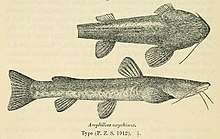Loach catfish
The loach catfishes are a family, Amphiliidae, of catfishes (order Siluriformes). They are widespread in tropical Africa, but are most common in streams at high elevations; most species are able to cling to rocks in fast-flowing streams.[2] The 13 genera contain 68 species.
| Loach catfishes | |
|---|---|
 | |
| Amphilius grandis | |
| Scientific classification | |
| Kingdom: | Animalia |
| Phylum: | Chordata |
| Class: | Actinopterygii |
| Order: | Siluriformes |
| Superfamily: | Loricarioidea |
| Family: | Amphiliidae Regan, 1911 |
| Genera | |
|
Subfamily Amphiliinae | |
The family Amphiliidae has three subfamilies, Amphiliinae, Leptoglanidinae (previously misspelled Leptoglaninae), and Doumeinae.[3] The monophyly of Amphiliidae has been questioned; one author restricts the family to the members of the subfamily Amphiliinae and transferred the other genera to a family Doumeidae.[3] The Amphiliidae have been previously thought to be a basal taxon in the superfamily Loricarioidea, but some authors place their relationships elsewhere.[2][4]
Description
Amphiliids are generally small catfishes with tapering, elongated bodies. The pectoral and ventral fins are large, and the first ray of each is usually broad, flexible, and filamentous. The eyes are generally small and located in the upper part of the head. The gas bladder is reduced and divided into two lobes surrounded by bony capsules.[5]
These catfishes have three pairs of barbels (nasal barbels are absent). The dorsal and pectoral spines are absent, or weakly developed (as in Leptoglanidinae and Trachyglanis). They reach 19 cm (7.5 in) at a maximum, but most species do not exceed 12 cm (4.7 in) in length.[2] The small mouth is located on the underside of the head, and has thick lips bearing several soft lumps (papillae). The lips, together with tentacles, and with minute spines on the fin rays, enable the fish to grip solid surfaces, so they can hold on in fast-moving streams.[6]
The biology and ecology of these fishes is poorly known. They are of little economic value, though they may be of some interest to aquarists.[5]
References
- Ferraris, C.J. Jr., Vari, R.P. & Skelton, P.H. (2011): A new genus of African loach catfish (Siluriformes: Amphiliidae) from the Congo River basin, the sister-group to all other genera of the Doumeinae, with the description of two new species. Copeia, 2011: 477–489.
- Nelson, Joseph S. (2006). Fishes of the World. John Wiley & Sons, Inc. ISBN 0-471-25031-7.
- Ferraris, Carl J. Jr. (2007). "Checklist of catfishes, recent and fossil (Osteichthyes: Siluriformes), and catalogue of siluriform primary types" (PDF). Zootaxa. 1418: 1–628. Retrieved 2009-06-25.
- Sullivan, JP; Lundberg JG; Hardman M (2006). "A phylogenetic analysis of the major groups of catfishes (Teleostei: Siluriformes) using rag1 and rag2 nuclear gene sequences". Mol Phylogenet Evol. 41 (3): 636–662. doi:10.1016/j.ympev.2006.05.044. PMID 16876440.
- Skelton, Paul H. (1992). "Amphiliidae (French)" (PDF). Faune des poissons d'eaux douces et saumâtres d'Afrique de l'Ouest. Tome 2. Musée Royal de l'Afrique Centrale, Tervuren, Belgique and O.R.S.T.O.M., Paris, France, 902. pp. 450–467. Retrieved 2009-06-25.
- Geerinckx, Tom; Brunain, Marleen; Herrel, Anthony; Aerts, Peter; Adriaens, Dominique (January 2007). "A head with a suckermouth : a functional-morphological study of the head of the suckermouth armoured catfish Ancistrus cf. triradiatus (Loricariidae, Siluriformes)" (PDF). Belg. J. Zool. 137 (1): 47–66. Archived from the original (PDF) on 2007-09-27. Retrieved 2007-07-24.
| Wikispecies has information related to Amphiliidae |